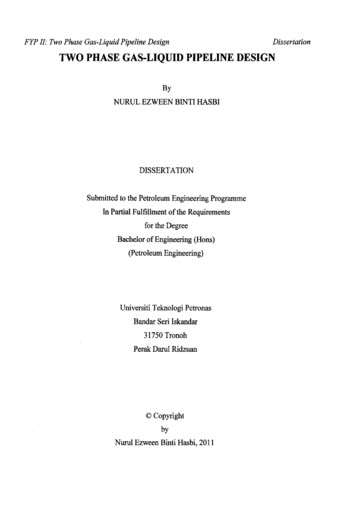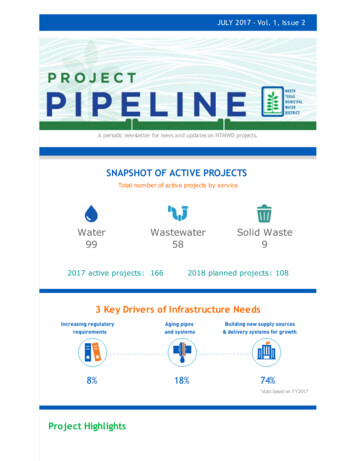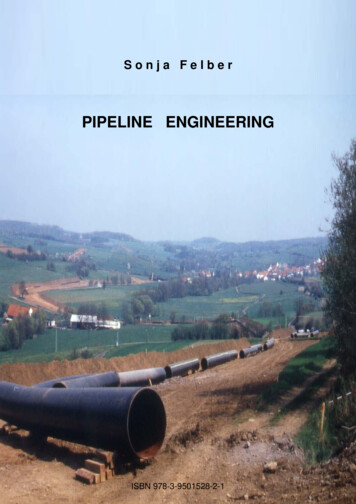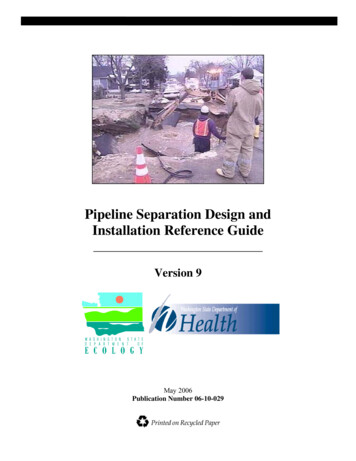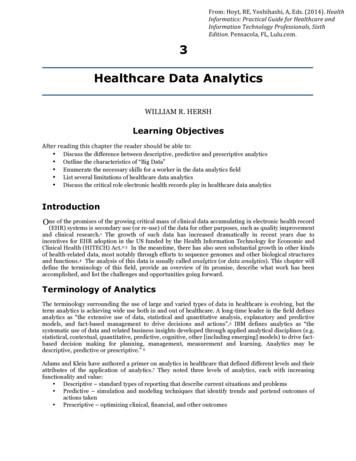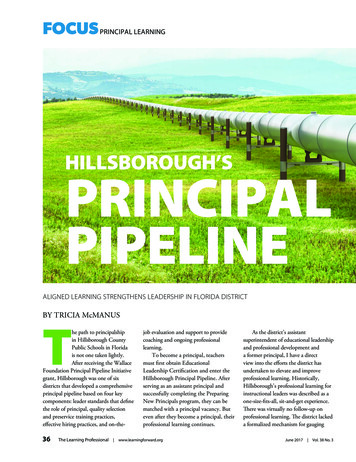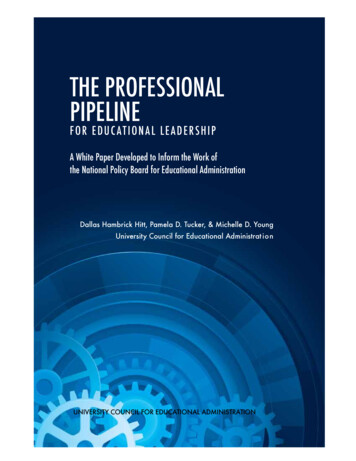
Transcription
THE PROFESSIONALPIPELINEF O R E D U C AT I O N A L L E A D E R S H I PA White Paper Developed to Inform the Work ofthe National Policy Board for Educational AdministrationDallas Hambrick Hitt, Pamela D. Tucker, & Michelle D. YoungUniversity Council for Educational Administrat i o nUNIVERSITY COUNCIL FOR EDUCATIONAL ADMINISTRATION
The Professional Pipeline for Educational LeadershipInforming Educational Policy:A White Paper Developed to Inform the Work ofthe National Policy Board for Educational AdministrationThe project team members for this white paper includedDallas Hambrick Hitt, Pamela D. Tucker, and Michelle D. YoungUniversity Council for Educational AdministrationThis white paper addresses dimensions of the professional pipeline for educational leadership. Itidentifies key issues and challenges associated with the current state of the leadership pipeline,including recruitment, selection, preparation and development, reviews research on the relationshipsbetween these features of the leadership pipeline and effective leadership practice, and provides a setof research-based strategies for supporting a strong leadership pipeline. There are many emergingtrends and promising new practices that are not, at this point, supported by a strong base of research.These strategies and trends will be the focus of future white papers. This white paper and therecommendations herein were prepared by the University Council for Educational Administration for theNational Policy Board for Educational Administration. Please direct any questions to ucea@virginia.edu.Copyright 2012The University Council for Educational AdministrationAll rights reserved.NPBEAThe National Policy Board for EducationalAdministration is a consortium of nationalstakeholders in educational leadership.The NPBEA works with government andeducational leaders, through its members,to promote changes in policy and practicethat support the learning of all children in ournation’s school. At the heart of the NPBEA’sefforts are the ISLLC and ELCC standards,which influence the preparation and practiceof our nation’s educational leaders.UCEAThe University Council for Educational Administration is a consortium of higher education institutions committed to advancing the preparationand practice of educational leaders for the benefit of schools and children. UCEA promotesthe application of research to practice in highereducation and K-12 settings. Because ourmembers prepare future leaders for schoolsand school systems, our community extendsinto districts, schools, and classrooms—thevery spaces where children learn and grow.www.ucea.org
The Professional Pipeline for Educational LeadershipThe professional pipeline represents a developmental perspective for fostering leadership capacityin schools and districts, from identification of potential talent during the recruitment phase to ensuringcareer-long learning through professional development. An intentional and mindful approach to supporting the development of educational leaders throughout their professional careers is critical to those whoaspire to educational leadership and those who comprise the ranks of current administrative positions.How the profession enacts phases of the pipeline and the quality of these experiences serve as a message to candidates and practitioners alike. How we recruit, prepare, induct, and develop educationalleaders may influence the expectations of and commitment levels to the profession of both candidatesand practitioners, and ultimately may affect our ability to recruit and retain the most capable. Given thesweeping influences of effective educational leadership, our schools, teachers, children and communitiesdeserve highly qualified, rigorously prepared leaders.1Given the sweeping influences ofThis white paper seeks to outline the distinct phases of building the professional pipeline, share research concerning effective effective educational leadership,practices for each, and draw attention to the inter-related nature of our schools, teachers, children,the phases. For example, preparation programs maximize their ef- and communities deserve highlyfectiveness when districts and universities work together to recruit qualified, rigorously preparedthe right people into leadership roles. The preparation of educational leaders.leaders requires the strategic and intentional coordination of effortsby multiple stakeholders in leadership preparation and practice: professional organizations, state departments of education, higher education, and school districts. Each entity possesses a stake in highlyqualified educational leaders and can make an important contribution to ensuring the caliber of educatorswho lead our schools and school districts. See the Table and Figure.Figure. Professional Pipeline for lDevelopmentPractice1
Table. Recommendations for Preservice and In-Service Educational LeadershipRecommendationsArea1Preservice educational leadership234Recruitmentof candidatesinto preparationprogramsDevelop districtuniversitypartnershipsand encouragerecruitment fromwithin.Reduce the financialburden of leadershippreparation.Recruit candidateswho reflect the richdiversity of schoolcommunities.Promote betterworking conditionsfor educationalleaders.Selection ofcandidates forpreparationprogramsRequiredemonstratedsuccess asa classroomteacher.Requiredemonstratedsuccess in leadingadults in somecapacity.Require an advanceddegree.Screen for passionand commitmentto leadership.Structure anddelivery ofpreparationprogramsMaximize socialsupport networksOptimize candidategrowth throughcontinual cycle ofassessment andfeedback.Provide achallenging, relevantand standards-basedcurriculum.Focus onfield-basedexperiences andeffective adultlearning practices.Structure careerladders foreducational leaders.Consider schoolcontext and individualcapabilities whenmaking a match.Use behaviorbased interviewingin the selectionprocess.Induction of novice Design a coherent Develop high-qualityleadersand intentionalmentors throughinduction program. careful selection andongoing support.Provide professionalopportunities beyondthe district to engagein dialogue andreflection.Consider inductionduration andtiming.Professionaldevelopmentfor practicingeducational leadersIndividualize thecontent and focusof professionaldevelopment.Enrich theinstruction inprofessionaldevelopment.1234In-service educational leadershipRecruitment andselection intoprofessionalpositionsCreate supportiveconditions forleadershipdevelopment.12 34Ensure time isset aside forprofessionaldevelopment.Assess the impactof professionaldevelopment.2
Recruitment of Candidates Into Preparation ProgramsHow the education profession presents itself in terms of the caliber of leaders in schools and schooldistricts, and the conditions in which they work, may be the best form of recruitment. Establishingrigorous selection standards encourages candidates whohave relevant and competitive skills to aspire to join the ranksHow the education profession presentsof educational leadership, and involving stakeholders in theitself in terms of the caliber of leadersprocess affords an authentic and grounded process.2 At times,the use of incentives may be useful to deepen the applicant in schools and school districts, and thepool. Recruiting with diversity in mind yields a more hetero- conditions in which they work, may begeneous applicant pool from which school communities may the best form of recruitment.select candidates to fit their unique context.Recommendation 1: Develop district-university partnerships and encouragerecruitment from within the districtAs current and past supervisors and evaluators, districts acquire keen insight into teachers who shouldbe encouraged to pursue educational leadership. Supervisors at the building and district level observethe day-to-day interactions and practices teachers exhibit. This first-hand knowledge can serve asa screening mechanism for university preparation programs. While universities intend for letters ofrecommendation to serve this function, this approach still relies on the initiative of the candidate andcan be pro forma. Greater emphasis should be placed on good recruits nominated by districts versusself-nominated individuals.3 District and educational leaders have intimate awareness of contextualissues that should have a bearing on candidate selection. School districts can make practitioner-based,insightful recommendations about individuals. Recommendingan individual also suggests the level of support the district will Building ways for districts andprovide in later stages of the pipeline process, including the universities to authenticallyinternship experience during preparation, hiring consideration, collaborate and make sharedand future development. Building ways for districts and univerdecisions strengthens the relationshipsities to authentically collaborate and make shared decisionsas well as the profession.strengthens the relationship as well as the profession.Recommendation 2: Reduce the financial burden of leadership preparationRecruiting and then supporting the right people for educational leadership preparation may be addressedpartially by removing financial burdens associated with the career pathway. Given the salaries of teachers, university tuition makes the cost of preparation programs a deterrent to entering the profession.Some districts work with universities to find ways to make attendance feasible by developing tuitionreimbursement programs or even paying outright for a recruit’s fees. Districts that extend financialsupport for the recruit mutually benefits both parties because this type of sponsorship positively influences the recruit’s self-perception as a potential educational leader and helps to ensure a qualifiedapplicant pool for districts.Recommendation 3: Recruit candidates who reflect the rich diversity of schoolcommunitiesOften, a successful educational leader shares similar life experiences or cultural backgrounds withtheir faculty and students.4 Moral and ethical imperatives demand recruitment for diversity, and research supports the benefits for schools as organizations and the students they serve. We live in adiverse society, with student populations that mirror the various cultural, ethnic, and socioeconomic3
backgrounds of our citizens. It follows that schools need a diverse pool of leaders to draw from whenmaking a match, given the increased likelihood for success when an educational leader in someway resembles the school organization. Recruitment serves as an opportunity to ensure we have aheterogeneous and well-qualified pool of applicants from which schools may choose.Recommendation 4: Promote better working conditions for educational leadersTeachers who decide not to enter the administrative ranks often cite the working conditions ofeducational leaders, both at the building and district levels, as a concern. While the working conditions may be seen as an effective selection tool that deters the faint-hearted, consideration shouldalso be given to the reasons principals leave the field and teachers decline to enter it.5 A betterunderstanding of why some leaders exit the profession may assist in the successful recruitment andretention of talented educators. Most who become public educators do so for perceived potential jobsatisfaction and efficacy rather than monetary benefits. Professionals who do not expect high levelsof monetary compensation instead expect more meaningful and satisfying work. Given the salaryscale for educational leaders, working conditions increase inA better understanding of why some relative value to compensation. Supportive working conditionsthat enable effective educational leadership on behalf of betterleaders exit the profession mayschool environments for students is a potent recruitment toolassist in the successful recruitment for the profession, for its preparation programs, and ultimatelyand retention of talented educators. for school systems.Selection of Candidates for Preparation ProgramsAdmission, rather than selection, tends to be the process by which universities cull students forpreparation programs. The distinction between the two activities is important: admission connotesmeeting minimum requirements, whereas selection indicates that admission is a necessary but insufficient condition. Selection implies that schools assemble a pool of qualified applicants, and thenfrom that pool individuals are purposefully, thoughtfully, and deliberately chosen. Meeting a minimumgrade point average (GPA) and test-score threshold provides a far different applicant pool than requiring career and professional experiences aligned with the act of improving student achievementvia working through others or exercising influence. GPA and test scores give us insight into the academic dimension of individuals but “are virtually useless in projecting performance in administrativepractice.”6 Further, some programs require neither, and for others, the current standards for GPAand test scores are so low that “most educational leadership programs lack rigor.”7The following set of recommendations focuses on discussing empirically supported recommendations for the practice of selecting potential school administrators whose profiles demonstratepromise and potential as educational leaders and questions the current widespread reliance uponundergraduate GPA and test scores. Literature on recruitment and selection asserts that educationalleadership preparation programs cannot compensate for an individual’s lack of prior exposure toleader roles.8 Instead, preparation programs serve as a way to hone and harness existing strengthsand proclivities. In consideration of this reality, four key practices are recommended.Recommendation 1: Require demonstrated success as a classroom teacherAn individual’s experience as a classroom leader undoubtedly contributes to success as an educational leader. A strong foundation as a classroom teacher provides potential educational leaders with4
the experience and insight necessary to lead others who continue to occupy that role.9 Individuals withstrong instructional backgrounds are better able to relate to and lead teachers, and identify and modeleffective classroom practices. In short, successful teaching experience indicates the ability to lead aclassroom, with the classroom being a microcosm of the school.10 Furthermore, it reflects a foundation for instructional leadership as the educator moves into an educational leadership position. Froma practical standpoint, limited teaching experience is correlated with decreased likelihood of enteringeducational leadership and can be seen as jeopardizing anindividual’s likelihood of seeking an administrative position.11Despite the reasons to select candidates based onteaching experience, of 450 programs surveyed, only 40%required teaching credentials or K-12 teaching experience.Furthermore, 60% allowed those enrolled in preparationprograms to simultaneously complete minimum teachingrequirements.12Individuals with strong instructionalbackgrounds are better able to relateto and lead teachers, and identify andmodel effective classroom practices.Recommendation 2: Require demonstrated success in leading adults in somecapacityThe field of educational leadership recognizes that leaders work primarily through others. That is, theireffects on student achievement are indirect and are mediated by the school environment and teachers.13 Schools experiencing success generally have leaderswho exercise influence in a way that supports and enables The field of educational leadershipteaching and learning through setting direction for the school, recognizes that leaders work primarilysupporting and facilitating the development of both individu- with and through others.als and the greater organization, as well as harnessing andleveraging contextual strengths of the school to facilitatestudent success.14Individuals who come to educational leadership preparation programs with previous experiencein leading adults in educational settings demonstrate their leadership skills and potential, in contrastto teachers whose career histories only include exercising influence over students. The transition fromleading a classroom to leading a school involves a steep learning curve that may be better addressed bya combination of preparation program learning and prior knowledge garnered through lived experience.15Such prior leadership roles may include department head, dean, grade level chair, or team leader.Recommendation 3: Require an advanced degreeProspective educational leadership students should already be equipped with an education-relatedadvanced degree (masters or more) before seeking administrative credentials. This accomplishmentdemonstrates greater commitment to teaching and education of students in general.16 When individualsshow the initiative to earn a degree in English as a second language, reading, mathematics, science,or other curriculum-related area, they further elevate themselves from the applicant pool in terms ofcommitment to and expertise in teaching and learning, and also elevate themselves in terms of garnering respect from the future faculties they will be charged with leading.Requiring advanced degrees listed above strengthens an educational leader’s ability to practiceinstructional leadership.17 There are many dimensions of effective educational leadership, but having a solid grasp of curriculum, instruction, and assessment is fundamental to earning the respect ofclassroom teachers to lead instructional programs and improving student achievement.5
Recommendation 4: Screen for passion and commitment to leadershipEmpirical work makes the roles of effective educational leaders increasingly clear, and we now knowthat leaders indirectly influence students through teachers, yet that insight has not been used fullyto select potential educational leaders. Asking educational leadership candidates if they understandthe importance of working with adults seems to be an appropriate starting place, as does examiningcareer histories for evidence of such an inclination. Currently, research indicates that many studentsof educational leadership express more commitment to working with students than they do to workingwith adults.18 Future educational leaders should possess significant interpersonal skills and commitment to addressing the issues and challenges of managing and developing adults, yet we find currentlythat upon completion of educational leadership programs, many individuals prefer to remain in theclassroom. As noted by researchers, “over credentialing is no way to build a profession,” and is costlyin terms of time, attention, and resources left for those who genuinely desire to work with adults.19Structure and Delivery of Program PreparationOf the pipeline phases, preparation programs provide the most robust sources of research on effectivepractices, thereby allowing the field to assert with relative certainty the facets of appropriate experiencesfor students of school administration.Recommendation 1: Maximize social support networksFor a number of reasons, admitting, matriculating, and preparing students as a group makes sense.20Students learn and are afforded an improved opportunity to practice much valued interpersonal andcollaborative skills. Supportive networks can be developed in a number of ways, but organized cohortsfor program delivery are ideal. Cohorts begin as an assembly of individuals, but through the navigatingof shared experiences, peer support and trust is often built and a community of learners and practitioners emerges. Engaging in a cohort allows preservice administrators to experience the formationof community21 and negotiate professional and collegial relationships, similar to the challenges theywill be charged with upon accepting a position as an educational leader. As discussed in the Selectionsection, much of an educational leader’s work entails interacting with and developing adults. The cohortprovides an accurate glimpse of an administrator’s work-life as he or she transitions from leader ofthe classroom to leader of the school,22 and allows the preservice leader a safe yet authentic place topractice the skills in organizational and individual development that preparation programs’ curriculumshould reflect.Recommendation 2: Optimize candidate growth through a continual cycle ofassessment and feedbackOver the last decade, many preparation programs engaged in restructuring their experiences to reflectthe changing demands of an educational leader.23 This type of work increases in importance as webegin to understand how different expectations for educational leaders link to preparation programs.24Beginning with the end in mind clarifies what educational leadership preparation programs want theirgraduates to know and be able to do. Clarity about preparation program outcomes guides the development of meaningful assessments and the necessary mechanisms to scaffold the student learningexperience in meeting the standards set forth by the assessment.6
Summative assessment. Before earning leadership credentials, students should be required todemonstrate proficiency in a multifaceted summative assessment. Including an examination aligned withnational and state standards in the assessment battery ensures that students have mastered the body ofknowledge critical to role before stepping into a leadership position. To supplement the exam, studentsshould develop, with the guidance of a mentor or universityadvisor, a cumulative portfolio providing further evidence of Beginning with the end in mindthe ways the student has met state and national standards clarifies what educational leadershipduring their preparation program experiences. The portfolio preparation programs want theirshould include a leadership platform that communicates the graduates to know and be able to do.candidate’s deep understanding of educational leadership.25Formative assessment. The development and implementation of formative assessments assistsprograms in reaching clarity regarding student outcomes and serves as tool for monitoring studentdevelopment and status throughout their participation in a program. Formative assessments providefeedback for the candidate and assist faculty in understanding the student’s progress toward theeventual mastery of the knowledge and skills required in the summative assessment. Currently, rubricsaid faculty in examining and assessing students’ work. Depending on the nature and importance ofstudent work, multiple faculty members can examine the student work using the same rubric to helpensure reliability and rigor.26 Although the development of the rubric tends to be a difficult process,implementing rubric-based assessment clarifies the desired outcomes for students and adds a levelof impartiality to the judgment process for faculty. Clearly defined learning outcomes not only leaveslittle room for doubt about what the student should strive for, but also moves the profession towardwidely accepted and understood criteria that are rigorous and research based.Recommendation 3: Provide a challenging, relevant, standards-based curriculumThe common foundation for most preparation programs is the nationally recognized Interstate SchoolLeaders Licensure Consortium (ISLLC) standards.27 These standards include (a) development of avision for learning, (b) nurturance of a culture of learning, (c) management of the organization, (d)collaboration with the school community, (e) ethical and fair conduct, and (f) advocacy and influenceon the broader context of schooling. These national standards and their reflection in accreditationstandards create a framework for designing curriculum better aligned with the challenges that graduates will face on the job, such as working with increasingly diverse communities, collaborating withexternal agencies, and more seamlessly integrating technology.In addition to these standards that define the knowledge and skills that need to be mastered ina preparatory program, research demonstrates that program features are just as important. A set ofessential core program attributes includes a well-defined, leadership-for-learning focus; coherence;challenging and reflective content; student-centered instructional practices; competent faculty; positivestudent relationships; a cohort structure; supportive organizational structures; and substantive andlengthy internships.28 Programs aligned with the ISLLC standards that include the above researchbased program attributes are more likely to produce graduates who are well prepared to providehigh-quality leadership in their schools and communities.Recommendation 4: Focus on field-based experiences and effective adult learningpracticesLearning, refining, and mastering knowledge and skills related to facilitation of positive school culture,community relations, school improvement, social justice, and competent school management maybe best approached through a blend of learning experiences that span traditional classroom-basedcoursework and field-based experience and inquiry.29 We also know that adults learn differently thanyounger students, and an emphasis on meaning-making through application of knowledge generally7
engages adult learners in ways that an emphasis on lectures and readings cannot. More powerfullearning experiences involve field-based activities as part of course requirements. A combination offield-based experiences that are followed by sense-making activities helps students better understandthe realities of educational leadership and provides an authentic way to develop the knowledge andskills necessary for a grounded understanding of educational leadership.Generally timed as a capstone experience in a preparation program course sequence, the internship experience allows students to immerse themselves in the daily practice of an educational leaderunder the guidance of a mentor who is paving the way for them in terms of access to work with increased responsibility. Theory meets practice as the internship arrangement also calls for the presenceof a university clinical faculty member who ensuresthat the student intern encounters experiences thatIdeally, the practitioner mentor and the are planned, purposeful, and aligned with stateclinical faculty member participate in and national criteria for certification.30 Ideally, theindividualizing and personalizing the practitioner mentor and the clinical faculty memberinternship experience in a way that challenges participate in individualizing and personalizing thethe student intern to apply knowledge and internship experience in a way that challengesthe student intern to apply knowledge and skillsskills garnered through previous courseworkacquired through previous coursework leading upleading up to the internship. to the internship.31Recruitment and Selection Into Professional PositionsThis phase of the pipeline is all about finding the right match and entails considering context, an applicant’s background, and the contextual support for the potential school leader. Applicants with competitive skills look for work environments that support and develop their existing skills, and savvy schoolslook for ways to meet applicants’ needs. Underperforming schools occupy a particularly vulnerableposition in the recruitment and selection process.Recommendation 1: Create supportive conditions for leadership developmentCompetitive and well-informed applicants may make decisions about job acceptance based on theworking conditions of a particular position. Self-aware applicants know the value of working for a directsupervisor who displays the leadership qualities necessary for empowering adults—both within thefaculty and the administrative team. A school’s reputation generally derives from the leadership manifested by the principal and how he or she taps into teacher capacity and sets an example for assistants.Prospective administrative new hires likelyknowthat the principal will serve not only as aProspective administrative new hires likelysupervisor, but also an in-house mentor. Potentialknow that the principal will serve not only as aassistant principals largely approach the assistantsupervisor, but also an in-house mentor. principal position as a training ground for the principalship and look for principals who will afford themgrowth opportunities and exposure to a spectrum of responsibilities reflective of their future positions.Such exposure will benefit not only the individual, but ultimately the future of the profession, for it isthe quality of assistant principals’ learning and growth that helps determine the quality of tomorrow’sprincipals.8
Recommendation 2: Structure career ladders for educational leadersResearch demonstrates that principals who only served as teachers and skipped the role of assistantprincipal are more likely to leave the profession.32 Ideally, school districts should intentionally developleadership capacity through a full range of leadership roles for teachers and novice administrators.For example, the time spent as an assistant principal helps prepare future principals and functionsas an extension of the more formal learning during preparation programs. Districts invite the cripplingeffects of rapid leader turnover when they do not support the development of leaders throughout theirorganizations.Recommendation 3: Consider the school context and individual capabilities whenmaking a matchWe know that leaders whose careers include previousexperience working with student populations demo- Leaders whose careers include previousgraphically similar to those of the school recruiting experience working with student populationsand selecting them have been found to function at demographic
The Professional Pipeline for Educational Leadership The professional pipeline represents a developmental perspective for fostering leadership capacity in schools and districts, from identification of potential talent during the recruitment phase to ensuri

